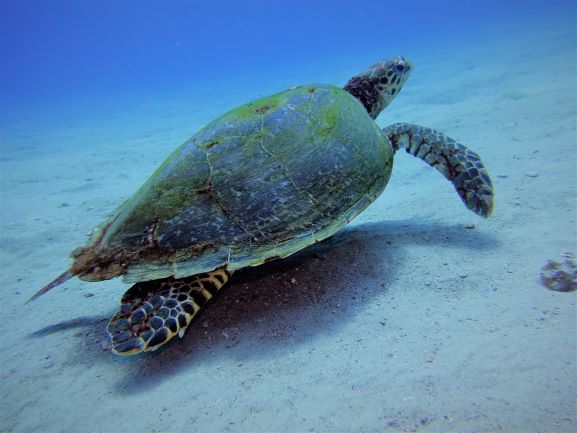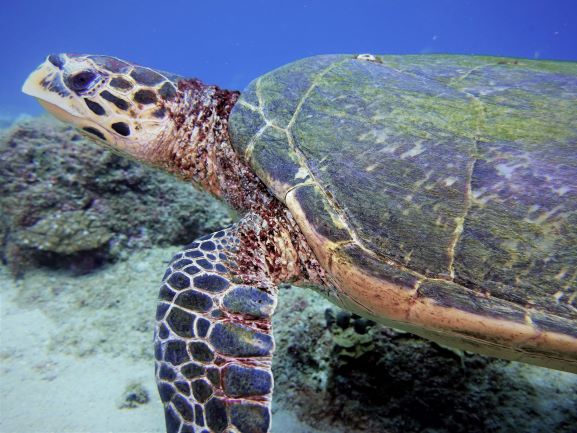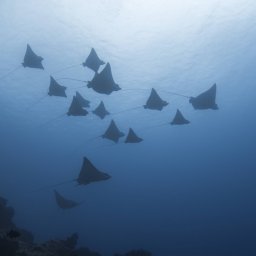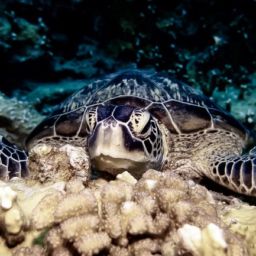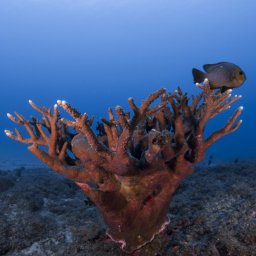Let’s get to know SeaTurtles a little better
SeaTurtles are some of the oldest living animals on our planet, ALL of our turtle species have been around for 110 million years, unchanged by time or activity.
There are seven different types of sea turtles going in size order from the smallest in the form of the Kemp’ Ridley at 60cm all the way up to the Leatherback which can grow to over double that at 180cm. The other species are Green, Hawksbill, Logger Head, Olive Ridley and Flatback
Turtles are reptiles which means they have cold blood, breath oxygen and lay eggs. Most species live in ambient tropical waters, and they will often ‘float’ to warm up (and breath). The eggs are laid and born on land and, for males, this will be the only time they will lay their fins on dry land Turtles use oxygen to breath and so have to surface at regular occasions. The green turtle can ‘hold its breath’ for up to five hours (by slowing its heart rate down) though most will surface ever five minutes or so, in between feeding.
Looks:
A turtles shell is called a carapace and is streamlined to cause as little friction as possible as it pushes itself through the ocean with its fin like legs.
They do not use their carapace in the same way as tortoises, never bringing their fins into the shell cover, instead their carapace acts as a defense and a boy ace device.
Turtles, along with other large ocean wonders, love to visit cleaning stations where fish will come and ‘clean’ their shells and scales, eating the algae and small creatures that have attached themselves to the turtle during migration journeys and feeding activities.
Diet:
Each individual species has a specific diet, though it is thought that all young turtles have a scavenging diet during their ‘lost years’ feeding on whatever they are able to find on their journey.
Diets can range from sea grasses, sponges and algae to jellyfish and crustations. Each individual species evolve, in adulthood, to have a specific diet and this is why they are so important in the ecosystems that they live in.
Predators:
As juveniles turtles have it hard, they are prey for just about every animal that finds them, from lizards, birds and crabs when they are on land, to fish, squid and anything else bigger than them when they are growing into adulthood.
Sharks, octopus and jellyfish have been seen to kill larger turtles but mostly when the turtles reach adulthood they are safe from aquatic predators.
The biggest threat to turtles is actually humans. Through historic collection and black market selling of their eggs, killing for meat and shell based souvenirs and jewelry to death through propeller injuries, being by catch or through injection of plastics and other ocean rubbish which is fast becoming the biggest cause of adolescent and adult turtle deaths across the world.
Migration:
Turtles do not feed and nest in the same areas. Most species have to travel 1000s of km from their feeding grounds back to the beaches they were born on, which is where they will always nest.
They use the magnetic poles to be able to relocate their original ‘birth beach’ and will travel back there ever 2-5 years to lay.
Males will also travel back to these areas but will mate in the waters off shore leaving the girls to travels the beaches to bury their eggs alone.
Nesting:
The females will lay between 70-200 eggs each time she comes up to nest on the beach
She digs a hole with her hind legs and then will go into a trance like state to lay the eggs carefully burying her babies before leaving them to rejoining the ocean.
She will come up to nest several times over the season, always coming back to the same beach.
Females do not have to actually mate with a male every time she lays, instead she can divide the sperm from one encounter and use it to fertilize multiple batches of eggs laid at different times during the season. This is useful as the males can be quite vicious in the act of mating and will allow the female to choose more accurately the best laying night
The hole is carefully dug to allow the eggs to hatch into both male and female turtles, the sex of the egg will be decided but the temperature of its incubation period in the sand. Males will come from cooler sand and females from warmer +30c
It can take between 6 and 10 weeks for the eggs to hatch, also it can take the turtles up to a week to wriggle their way up through the sand to reach the surface. It is then a mass rush to get themselves to the perceived safety of the waters, those little ones can really move!
Little is known about the “lost year” of young turtles, it is believed that they will swim out to floating islands and use this as their shelter from predators and the scorching sun whilst they learn to hold their breaths for longer diving times, harden their shells, strengthen their swimming fins and grow eating anything they can from their floating homes from algae, plankton and small crustations.
Adults will be able to mate from around the age of 25years, and they can live until they are about 80 years old.
Due to these reptiles being in the waters for most of their lives there is still a lot that is unknown, hopefully in the future we will be able to work together to plot migration patterns of individual turtles and with advancements in technology we will be able to learn more about the mysteries between hatching and laying. So much is still to be discovered about these prehistoric wonders I just hope we can change our behavior in time to allow them to live for another 110 million years!
